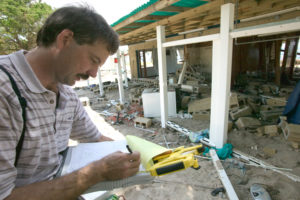
The Insurance Information Institute suggests several key “first steps” for settling insurance claims after a disaster:
- Contact your insurance company immediately
- Make temporary repairs
- Prepare for the insurance adjuster’s visit.
Once you are safely out of danger, it is time to think about how to manage insurance claims.
First, contact your insurance company. Insurance policies place a time limit on filing claims. The Texas Department of Insurance (1-800-578-4677) can provide you with the telephone number of your company if you don’t have it. When you speak to your insurance company, ask the following questions:
- What is my time limit for filing a claim and making repairs?
- What does my insurance policy cover?
- Will the company send someone out to assess the damage?
- Will I need to get estimates for repairs for structural damage? Should I wait until the company has sent someone to assess damages first, or should I go ahead and start this process?
- How much is my deductible (the amount of loss you agree to pay yourself when you buy an insurance policy)?
- How long will it take to process my claim?
- If I have to live elsewhere temporarily, will my policy reimburse me for those living expenses?
Second, make temporary repairs to protect your property, but be sure to ask your insurance company if this will help or hinder your claim. You are normally expected to take reasonable steps to protect your property from damage. Save all receipts for what you spend so you will be able to submit them for reimbursement. A recommended practice is to take pictures before you start temporary repairs. Be wary of contractors requiring a large sum of money up front, as well as those whose bids are very low.
Finally, prepare for the insurance adjuster’s visit. You may be sent a “proof of loss” form to complete. You will need to substantiate your losses. The more information you can provide about your losses the better. Recover any receipts to substantiate the inventory, if possible. Don’t throw away damaged items until the adjuster has visited. Photographs can be very helpful. Check with family members for photos of your home or its belongings. If most of your property was damaged and you have no records, you will have the challenge of working from memory.
Develop a list of everything you want the adjuster to check over. This can include the structural damage to your home (cracks in walls, damage to floor, ceiling, roof, windows), garage, tool shed, in-ground pools, etc. If your insurance company has encouraged you to get bids on repair work before the adjuster visits, make sure you get written bids from reliable, licensed contractors. Bids should be detailed and itemized to expedite the claims process.
Keep copies of all documents and lists you provide to your insurance company. Also, keep copies of any paperwork the insurance company gives you. Record the names and phone numbers of everyone with whom you speak. Note what you spoke about and on what date. It is easy to forget details in times of stress.
Source: Texas A&M AgriLife Extension Service. Financial Recovery: Homeowner’s Property Insurance Issues, publication ER-035, 9-23.
